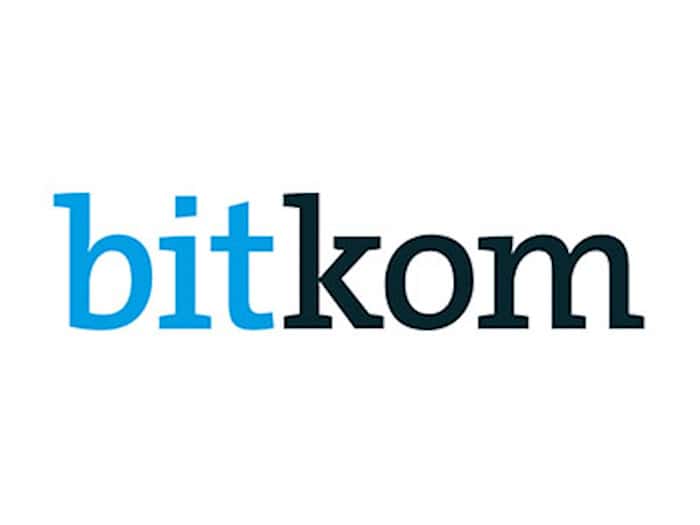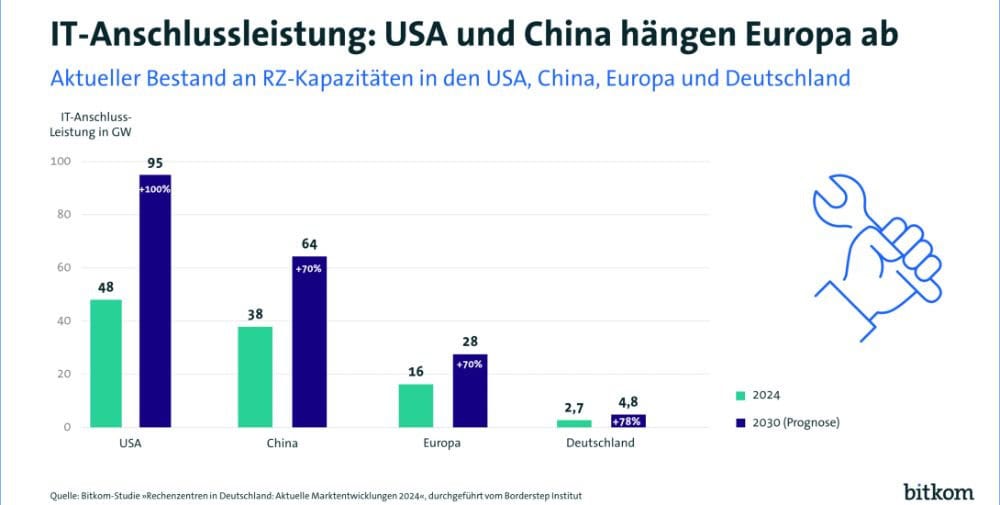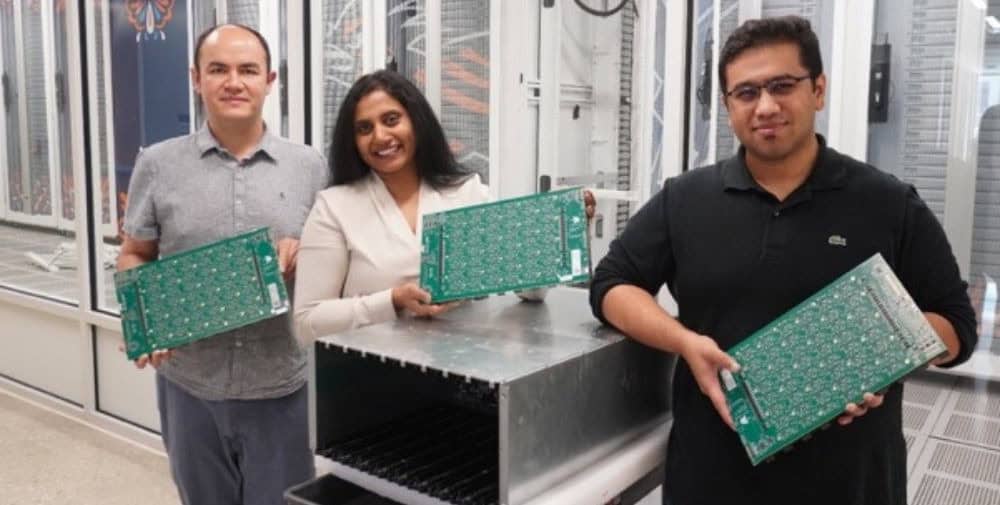
This puts China in second place worldwide with 38 gigawatts in 2024 and 64.3 gigawatts in 2030. “Data centers are the backbone of digitalization. Hardly any company or private household can do without the services of data centers, and public administration can no longer function without data centers,” says Bitkom CEO Dr. Bernhard Rohleder. “In the USA, two to three times as much new capacity is added every year as is installed in Germany. It is high time to take countermeasures. Without data centers, there is no digital sovereignty.”
Germany still has the highest computing capacities within Europe. Operators currently invest 2.9 billion euros a year in buildings and technical building equipment and a further 10 billion euros in IT hardware. Nevertheless, in terms of economic power, computing power is at a low level compared to other nations. In relation to gross domestic product, the connected load of data centers (610 kilowatts per billion euros of GDP) in Germany is lower than in the UK (670) or the Netherlands (930), for example. Ireland (2,310) is in the lead, which is mainly due to the branches of large tech companies in the country. It is followed by China with 2,100 and the USA with 1,700 kW of connected load per billion euros of GDP. Rohleder: “As the world’s third-largest economy, we must not lose touch, but must keep pace with the leading nations. Germany must position itself to be more capable, more resilient and more technology-oriented – and this is only possible with a strong and efficient IT infrastructure.”
Cloud data centers drive growth
In this context, the growth in data center capacities is primarily driven by the increasing expansion of cloud computing. Cloud data center capacities have practically doubled in the past 5 years: from 630 MW in 2019 to 1240 MW in 2024. Cloud data centers currently account for 45% of the market, compared to 29% in 2019. The edge data center market is also gaining momentum, although it is still at a rather low level with 180 MW of connected load in 2024. Traditional data centers will continue to be operated, although the downward trend is now visible (2024: 1,310 MW). There are currently a total of 2,000 data centers in Germany with more than 100 kW of IT connection capacity. This also includes around 100 very large data centers with a capacity of more than 5 MW. These account for almost half (48%) of the computing power in Germany. Whether cloud, traditional or edge: together, the data centers in Germany have a total IT connected load of 2,730 MW, compared to 1,590 MW ten years ago.
Energy demand is rising – also due to AI
Electricity demand has also risen – and will continue to rise, partly due to the growing importance of artificial intelligence. It will be 20 billion kilowatt hours in 2024 – compared to 12 billion kWh in 2014. How will it develop in the future? The Bitkom study calculates various scenarios: In the event of extreme growth in capacity, energy demand could increase to up to 37 billion kWh per year. If the current trend continues linearly, energy demand will increase to around 31 billion kWh by 2030. If above-average efficiency gains are achieved through modern infrastructure, hardware and software, the increase in energy requirements of data centers to 25 billion kWh in 2030 will be much lower, although Bitkom considers this scenario unlikely in view of current developments.
In a survey of data center operators and experts as part of the study, 80 percent stated that electricity consumption in data centers will increase due to the increased use of artificial intelligence. 71% also see an increase in power density, i.e. more computing power in a smaller space as a result of AI. Half (48%) expect increased energy efficiency and almost as many assume that AI will accelerate the growth of the data center industry in Germany as a whole. A quarter expect higher water consumption, as artificial intelligence and high-performance computing require more cooling. Operators are currently adapting the hardware in their data centers to the increasing demand for AI applications. Fifteen percent are already using special hardware for AI applications on a large scale and 44 percent on a smaller scale – a further 20 percent are planning to do so. AI and high-performance computing currently account for 15% of data center capacity in Germany, and the trend is rising rapidly. The forecast for 2030 is already around 40 percent. “Artificial intelligence will shape the economy and we need more artificial intelligence in and from Germany. Germany and Europe need to invest more in special hardware for AI,” emphasizes Bitkom CEO Dr Bernhard Rohleder.
CO2 emissions fall slightly – despite increasing performance
At the same time, operators are striving for greater sustainability and climate friendliness. The greenhouse gas emissions of German data centers tended to fall slightly between 2014 and 2024 despite the strong expansion of capacity. This is mainly due to the supply of electricity from renewable resources and increased energy efficiency. While CO2 emissions based on the German electricity mix were still at 6.9 million tons of CO2 in 2014, this figure is expected to be 6.5 million tons in 2024. The Energy Efficiency Act, which has been in force since November 2023, stipulates that all data centers with an IT connection capacity of 300 kW or more must be climate-neutral from 2027, at least on paper. Currently, this already applies to 66% of all data centers in Germany – including the smaller ones.
A large majority of data center operators are therefore ensuring a climate-friendly power supply. Three quarters (74%) already have green electricity contracts, while 27% purchase CO2 certificates or produce their own electricity from renewable energies. Among operators with more than 5 MW of connected IT capacity, the proportion of CO2 certificate purchasers is even higher at 50%. “The more sustainably data centers are operated, the smaller the carbon footprint of digitalization will be,” emphasizes Rohleder. “It is important that the next German government pushes ahead with the energy transition so that data centers are not only climate-neutral in terms of their balance sheet, but also in practice.”
There are still many obstacles to the use of waste heat
At the same time, data centers can contribute to the decarbonization of the heat supply – if their waste heat is used to heat residential or commercial areas, for example. The Energy Efficiency Act stipulates that new data centers with 300 kW or more must use part of their waste heat. 63% of the operators surveyed do this in principle, although half of them only use a small proportion of the waste heat, mostly for their own purposes. However, the proportion of operators using waste heat has risen significantly overall; in a survey in 2019, it was 39%. The biggest hurdle for waste heat utilization from the operators’ perspective is the lack of customers for the waste heat. Rohleder: “Many data centers would even give their waste heat away for free. In many places, however, the modern heating networks required for this do not exist. The fact that new data centers can currently only be located in places where such heating networks exist or are planned on a binding basis disproportionately restricts the possibilities for expansion. Data centers are needed where there is a high demand for computing power. With such requirements, which go far beyond the existing EU regulations, Germany is thwarting efforts to expand the digital infrastructure and increase its resilience.”
Frankfurt and Berlin most popular data center regions
Where do data centers currently prefer to locate? The Frankfurt metropolitan region with the surrounding Rhine-Main area continues to be Germany’s number one data center location: IT connection capacity of around 1,050 MW is currently concentrated here, which corresponds to more than a third of Germany’s total capacity. The greatest growth is expected in this region, with current plans assuming an additional 1,800 MW. Berlin-Brandenburg is also developing into an important data center location, but is lagging far behind Frankfurt: 140 MW of IT connection capacity is currently available around the German capital, with a further 900 MW to be added. The Rhineland is also gaining in importance, as are the greater Munich and Hamburg areas.
For operators, a reliable power supply is the most important location factor. In this criterion, Germany performs very well in an international comparison. Particularly important location factors in which Germany is rated very highly are the connection to internet nodes and data protection. Significant location disadvantages are seen with regard to electricity costs, lengthy and bureaucratic approval processes, regulatory requirements and a lack of available skilled workers.
Bitkom calls for a “Data Center Action Plan”
In order to promote Germany as a location overall and make it attractive for data center operators, Bitkom is calling for a “Data Center Action Plan”. Managing Director Dr. Bernhard Rohleder: “The next federal government must strengthen data centers in Germany in the long term in order to remain competitive. This requires the right regulatory conditions, lower electricity costs, an active location policy and optimized planning and approval processes.” As part of such an action plan, Bitkom proposes, among other things, a revision of the Energy Efficiency Act, particularly with regard to the required minimum standards for energy consumption effectiveness (PUE) and the proportion of reused energy (ERF). The reporting obligations would also need to be harmonized with the EU requirements. Competitive electricity prices are also needed. “The very high electricity costs compared to the rest of Europe are currently a decisive locational disadvantage for German data centers,” says Rohleder. In addition, approval procedures for data centers in other EU countries usually only take a few weeks, whereas in Germany, operators often face years of approval and planning procedures. “In order to meet the increasing demand for data centre capacities, approval and planning processes must be standardized, simplified, digitalized and accelerated,” says Rohleder. “The data center location needs a boost – and fast. A successful digital transformation of business and administration is not possible without high-performance data centers.”
– – – – –
Further links
www.bitkom.org
Graphic: Bitkom




